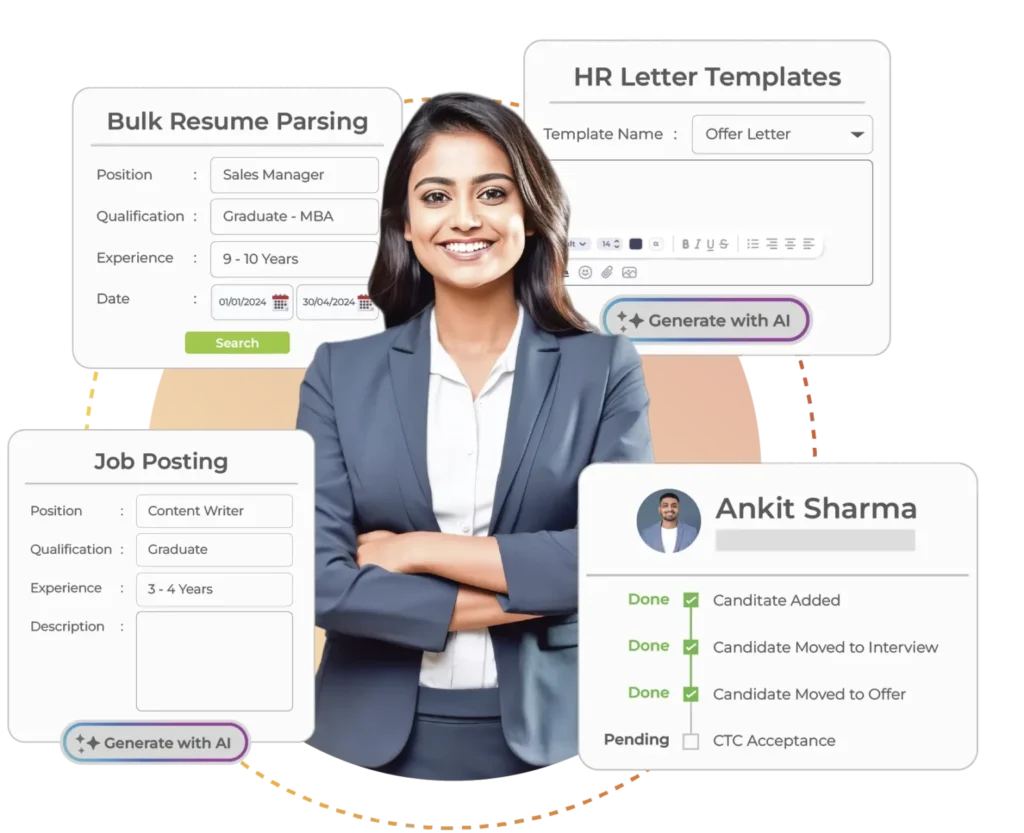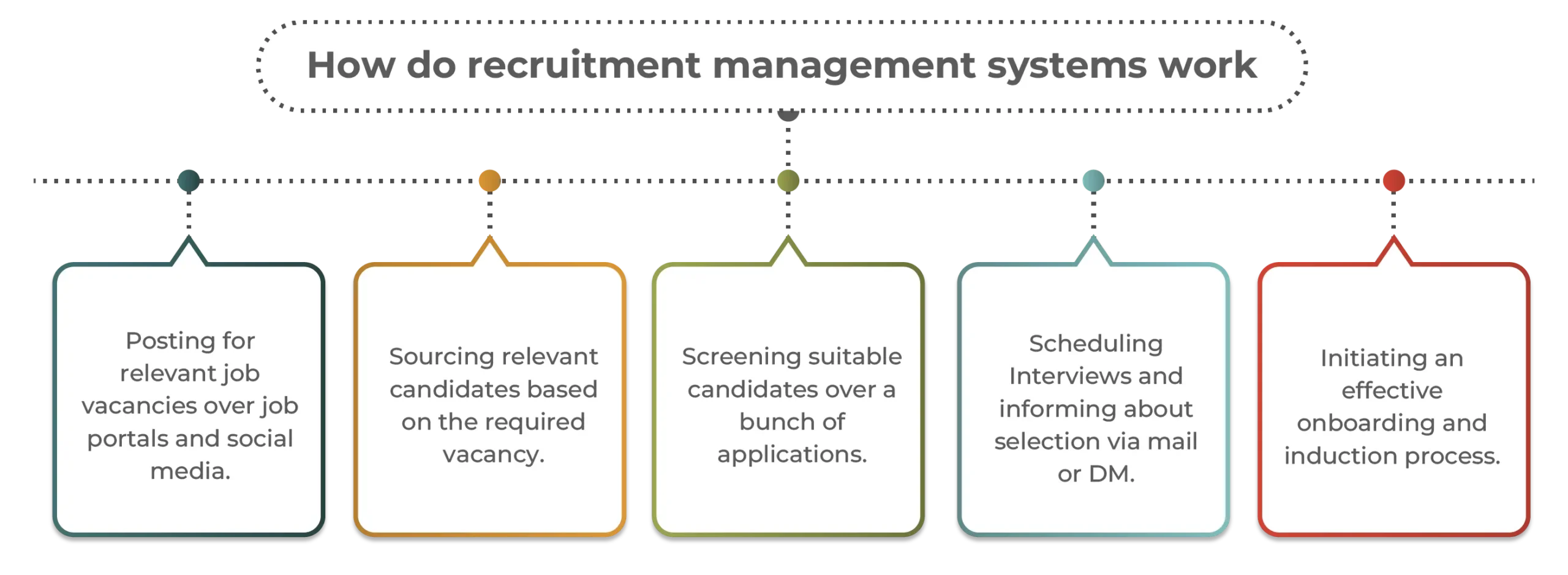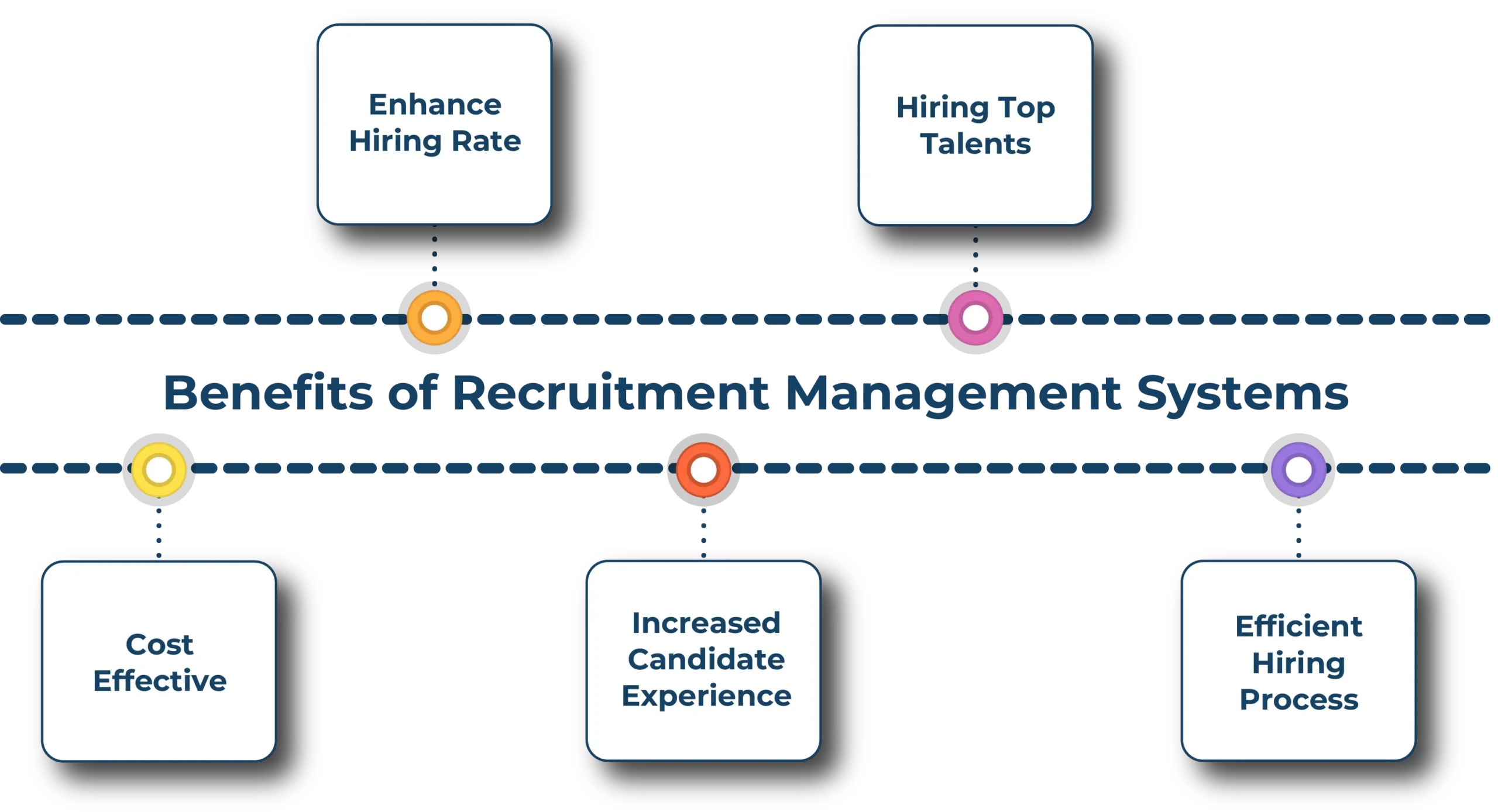Recruitment Management System
A recruitment management system is a platform designed to automate and manage the entire recruitment process, including job posting, parsing resumes, scheduling interviews, selection, onboarding, and seeking candidate feedback. The system mainly streamlines the hiring process and improves recruiters' efficiency.

Recruitment Management System Guide
What is Recruitment Management?
Recruitment management is the practice of hiring the right talent within a stipulated timeline. The process ranges from sourcing candidates, identifying and attracting them to attending interviews, selecting, hiring, and finally onboarding them on time. In addition to hiring, seeking feedback from new joiners, and conducting training to inform them about the company’s working style, upcoming goals and achievements, etc.
How do recruitment management systems work?
A recruitment management system works in typical flows, from planning to recruit the right talent to finishing the onboarding. Besides, it integrates with HRMS software to manage HRMS Payroll. Let’s discuss how the recruitment management system works during the candidate hiring process.
The recruitment software helps recruiters write the vacancy post in the right format and then assists them in posting it on relevant pages, platforms, or social media channels. Consequently, Employers attract sufficient talent for those particular positions.

1. Candidate Sourcing
With the assistance of the recruitment management system, employers can smoothly identify potential candidates through various channels, numerous job search platforms, and social networks. Besides, existing employees can refer someone to any particular relevant platform through the RMS portal.
2. Candidate Screening
After posting a job, employers receive a pile of resumes from different portals; the right recruitment management system automatically analyzes and parses the resumes to obtain the relevant information before scheduling the interview process and initiating the candidate selection.
3. Interview Scheduling
The system automates the interview scheduling process by coordinating with the shortlisted candidates via mail or DM and scheduling the interview date and time on the candidate’s calendar to keep them engaged. As a result, the candidate’s interview time does not overlap between the two companies, and the employer properly maintains each candidate’s interview schedule data.
4. Candidate Selection
In many companies, RMS automates the assessments and tests according to the required post vacancy. Additionally, added data analytic features offer detailed information on recruitment metrics and assist employers in decision-making. Different recruitment management tools even automate the selection mail or offer letters to candidates and provide feedback.
5. Initiating Negotiation
This system also offers applicant tracking features through which recruiters can track the candidate’s performance and salary expectations throughout the hiring process. So, after selecting the candidates, employers have valuable insight into how to draft negotiation strategies effectively.
6. Hiring and Onboarding
The transition from candidates to employees occurs during the onboarding process. Recruitment management software also automates this process by sending welcome emails, distributing employee handbooks and annexures, and completing paperwork in lieu of HR professionals. It often tracks the progress of the onboarding tasks.
Besides, with employee self-service assistance, employers gain circumstantial visibility into the onboarding processes, and the RMS adds the icing on the cake by following up with new hires in a timely manner.
Top 7 Features of Recruitment Management System
- AI-powered Schedule Automation
- Presence of Applicant Tracking System (ATS)
- Mobile Friendly User interface
- Analytics and Reporting
- Easy Integration
- Customizable Design
- Ample Storage Option
➔ AI-powered Schedule Automation
Employers can face logistical challenges when screening candidates and scheduling interviews. An AI-powered recruitment process automates the time-consuming, repetitive work and provides a streamlined solution for resume screening, candidate sourcing and outreach, interview scheduling, etc.
Besides, the automation process is integrated with calendar applications like Google Calendar or Microsoft Outlook and seamlessly added to the candidates’ calendars as a reminder.
Furthermore, the AI-powered recruitment management system empowers candidates by allowing them to select interview slots that align with their availability. It eliminates the need for excessive back-and-forth communication and scheduling conflicts.
Recently, the Times of India stated that automation has become effective as it eliminates the juggling of multiple HR responsibilities. According to a recent study, by 2022, 40% of HR will be using the automation process in candidate recruitment, while 60% won’t be able to rely on hiring tools and AI assistance; they will still be doing the work manually.
➔ Presence of Applicant Tracking System (ATS)
One of the essential features of a recruitment management system is an applicant tracking system and associate tracking tools. An application tracking system helps employers by automating resume shortlisting and evaluating the right candidate’s profile.
Moreover, after selecting talents, employers can initiate the onboarding process on time, as the ATS assists them in completing the task leading to onboarding.
➔ Mobile Friendly User Interface
It is essential whether the recruitment management system is mobile accessible. Nowadays, no one puts effort into searching for jobs by sitting beside a laptop at the end of the day. They randomly open job sites and search for suitable employment using any relevant mobile application.
So, the modern recruitment management system should have mobile-accessible features like a smooth user interface and intuitive touch controls so job seekers can easily navigate and complete the application process by uploading essential documents from their cloud storage using their smartphones or tablets.
➔ Analytics and Reporting
Before integrating any recruitment management system, it is essential to recheck whether it has features offering robust analytics and reporting functionalities. Understanding candidates’ essential data, analyzing it, and generating timely reports is a big task. Employers make mistakes or numerous mismanagement, and data swiping occurs while recruiting candidates.
These features help human resource professionals track key candidate performance metrics, such as candidates’ off rate, time to file, source of hire, cost-per-hire, etc. It provides valuable insight into the candidates’ data and allows them to make data-driven decisions and optimize strategies smoothly.
➔ Easy Integration
Before committing to a subscription, it is vital to review the recruitment management software and ensure it offers easy integration. A recruitment management system and associated ATS tools foster cross-functional team engagement in the selection process. These tools are pivotal in facilitating the process by easily sharing candidate profiles with management. They also allow external stakeholders and experts to participate in the candidate hiring process.
The collaborative approach streamlines the process when HR hires top talents or managerial experts and creates transparency within the organization’s hiring practices.
➔ Customizable Design
The recruitment management system ensures customizable branding, including modifying application forms, dashboards, and candidate portals to enhance usability and ensure a cohesive brand experience. It helps improve the candidate’s knowledge and maintain your brand identity throughout the interview process.
Moreover, this feature assists the HRS in adjusting the system’s settings to align with the unique recruitment strategies, improving efficiency and candidate engagement.
➔ Ample Storage Option
Employers may face challenges handling, managing, and storing vast amounts of applicant data during hiring. Though they successfully handle the selected candidate’s data, it becomes a nightmare for them to hold the candidate’s information, which can be effective for future recruitment.
Recruitment management software saves recruiters time by providing ample storage options. Hence, they can securely store the rejected candidates’ documents and other important information in cloud storage.
Benefits of Recruitment Management System
During hiring, a recruitment management system streamlines the entire process and automates the HRs’ repetitive work so they can focus on other administrative work during candidate recruitment. The HR software for recruitment has its own set of appealing features; some of the advantages are as follows,
1.Cost Effective
The entire recruitment process is time-consuming and costly. From the initial step, like planning for hiring, to onboarding the right talent for the relevant position, it costs a sound amount for each hiring. A right recruitment management system with all features automates HR tasks like candidate screening, sourcing, interview scheduling, and schedule onboarding. So, organizations do not have to spend extra money on each task; they subscribe to recruitment systems and automate the entire process.
2. Enhance Hiring Rate
Hiring top talent manually is time-consuming and troublesome, as employers can reach out within certain limitations. Moreover, they face challenges due to lacking a diverse search field within a specific timeline. As a result, they have to choose a random average candidate for a good position.
The recruitment management system RMS helps HR with diverse search opportunities, which attract 4x more genuine candidates and maintain a data-driven approach in every hiring phase.
3. Increased Candidate Experience
Employers’ main objective during recruitment is to find the right candidate among the many applicants. Similarly, when a candidate moves to change jobs, he applies to many companies. In this case, innovative branding and a smooth application process help to remind the candidate of the particular brand.
A hiring management system creates innovative branding and provides a relaxed and automated user experience to candidates while they apply for jobs. The system takes just a few minutes to complete the application, compared to the hours spent on other platforms, ensuring a positive user experience, thus leading to high-quality applicants in the talent pipeline.
4. Hiring Top Talents
A recruitment management system ensures high-end features like automated job posting, resume parsing, AI-driven candidate matching, etc. The approach assists employers in identifying the qualified or relevant candidates for the vacant position.
The system integrates with different job portals and social media platforms to expand the reach and visibility of job postings. With outstanding branding, the system helps attract more applicants, which creates a broader and more diverse candidate pool.
5. Efficient Hiring Process
A recruitment management system smoothens the hiring process by creating an effective and transparent process to find genuine candidates and improve the quality of hires. The system offers features and functionalities that automate the primary tasks like candidate sourcing, screening, scheduling interviews, and selecting relevant candidates during hiring.
Besides, recruitment HR software ensures the organization’s brand awareness, encourages candidates to join the company, and even assists employers in automating the reference method during recruitment.
Why does your organization need a Recruitment Management System?
With the latest recruitment trends, integrating and working with a recruitment management system (RMS) becomes mandatory. An RMS streamlines and automates repeating recruitment-related tasks, such as job posting, resume parsing, candidate tracking, etc. It mainly diminishes the administrative workload and reduces hiring duration.
Consider why your organization needs a recruitment management system to avoid the manual process.
- Recruitment systems save HR time and effort by automating the primary HR tasks and responsibilities, such as candidate searching, screening, scheduling interviews, etc.
- The hiring software can attract more candidates from diverse backgrounds since its search perimeter is practically limitless.
- Additionally, It introduces data-driven decision-making and continuous process improvement that assist employers in better talent choices.
- The RMS also introduces an HR chatbot, which provides seamless communication and collaboration opportunities and boosts the organization’s employer brand.
- Purchasing a recruitment system is a one-time investment, so employees don’t have to pay separately for every step when initiating recruitment for every candidate.
Overall, an RMS optimizes operational efficiency and elevates the quality of hires, giving organizations a competitive edge in the talent market.
How to choose the Right Recruitment Management System for your organization?
Before integrating the recruitment management system, one of the to-do tasks is to go through the factors and choose the reason for integrating the recruitment system.
- Understand Your Need
- Analyse Company Budget
- Check Out Features
- Think about ROI
- Best AI Assistance
- Listen to Reviews
➔ Understand Your Need
Before integrating randomly, visit your recruitment process and identify what you require and don’t. If you understand what is tripling up in your recent hiring strategies and what can be rectified, you can consider your first step towards finding the right solution.
➔ Analyze the Budget
After analyzing your ultimate requirement, the second essential task is to check your budget before planning the upcoming integration process. You must spend money alongside your business spending, so looking for a solution that balances features and affordability is essential.
➔ Check Out Features
Once you are aware of your needs and budgets, you should explore the features available in your chosen recruitment platform. Visit different software platforms and analyze whether their features suit your needs. You can also check whether the features provided streamline your work process and save valuable time.
➔ Think about ROI
One of the primary purposes of recruiting top talent is to drive positive business results and enhance productivity. So, before integrating a hiring system, it is essential to check whether it reduces cost, minimizes time, and provides data-driven solutions or whether you can start work, which results in a positive outcome.
➔ Best AI Assistance
The latest feature in recruitment systems is AI assistance, along with the system software. An AI-enabled system automates repetitive tasks such as candidate searching, screening, inviting and scheduling interviews, and onboarding during recruitment. Besides, it provides a 360° view of talent acquisition practices and lets them free from tedious administrative work during candidate recruitment.
➔ Reviews and Analysis
Finally, take some time to review the testimonials delivered by the other HRs or recruiters who have already used the system. They may provide you with valuable insight about whether it works well or if you should seek other support.
FAQs on Recruitment Managment System
Two main factors affect recruitment: internal factors and external factors.
The Internal factors include,
Company’s recruitment policies
Human Resource Practices
Size of the Organization
Total cost of the hiring process
The company’s growth and expansion
The external factors include,
Trending Market scenarios
Employment Rate
Competitors Position
Company’s Social Image
A recruitment management system is a powerful tool that streamlines the entire candidate hiring process, from candidate sourcing to seeking feedback. Here are details on how an RMS not only improves candidate experience but also significantly enhances company productivity.
Recruitment management software provides a user-friendly interface that simplifies the application process during candidate hiring. Candidate can smoothly submit their application without encountering any technical issues.
The RMS software ensures automated email notifications and keeps candidates updated with their application status, whether it is viewed or awaiting a view. It maintains transparency within the workplace.
RMS auto-adds the candidates’ names and other details during tailoring mail, reducing the candidate’s uncertainty and increasing engagement.
The RMS platform is mobile responsive so that candidates can review their status anytime.
RMS accelerates the candidate screening process through an auto-screening technique. It reduces hiring time by automating responses to candidates.
RMS often auto-collects the candidates’ feedback about the hiring and onboarding process to enhance future interactions.
Yes, recruitment management software can easily be integrated with other software applications. Likewise, Pocket HRMS recruitment software can easily be integrated with any HRMS and related HR tools.
Yes, the recruitment management system involves robust security protocols like encryption, access controls, two-factor verification, case-sensitive password access, etc. It introduces compliance with candidate personal data protection regulations like GDPR by maintaining audit trails and managing consents efficiently. For example, with Pocket HRMS, you can be absolutely confident about the security of your company data as we use Microsoft Azure Cloud, which provides 256-bit enterprise-level security.
Yes, training is required before integrating the recruitment management system into your system. However, rest assured, the system is designed for easy navigation and understanding. In this training, the employers get acknowledged for using the software and related tools and how to navigate them systematically.
The training can be self-paced online tutorials or in-person workshops from the software distributors. We, Pocket HRMS, provide a detailed description of the RMS system before integration.
There are several methods used to recruit employees, which are governed by various factors such as the job role being recruited for, the skillset and experience necessary for the role, the hiring budget, and more. Based on these factors, various methods can be used for recruiting, which include:
– Advertising on Job Portals
– Using Recruitment Agencies
– Social Media
– Providing Apprenticeships
– Providing Internships
– Employee Referrals
– Internal Promotions
– Internal Transfers
– Word of mouth.



